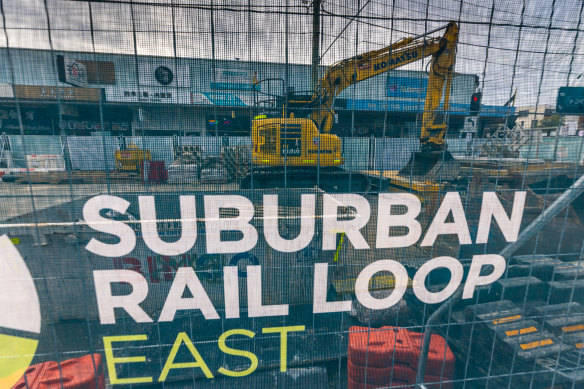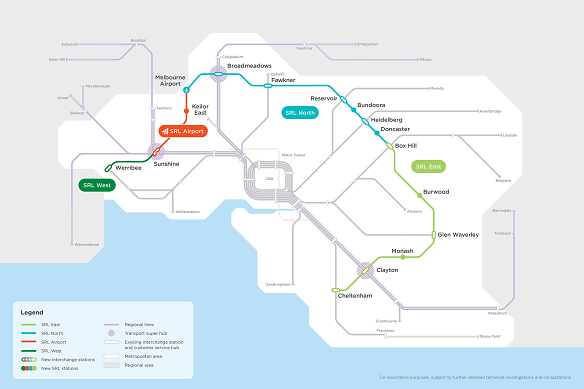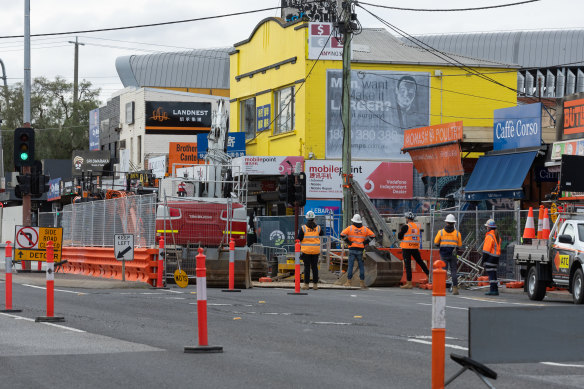Save articles for later
Add articles to your saved list and come back to them any time.
Victoria is considering using a public-private partnership to cover the cost of building the Suburban Rail Loop East, as the government faces a multibillion-dollar funding hole in its flagship infrastructure project.
The move could help the Allan government spread out the cost of its $35 billion underground railway between Cheltenham and Box Hill over multiple decades and ease pressure on its already stretched finances.
Suburban Rail Loop construction in Clayton last year.Credit: Jason South
Victoria has committed to pay for a third of the project at $11.8 billion, but soaring construction costs and inflation have put its hopes for receiving another $9.3 billion in Commonwealth funding into doubt.
Questions also remain about the state’s plans to fund another third of the project through developer contributions and other levies.
As Victoria faces the prospect of paying for a greater share of the project’s costs, a public-private partnership has been discussed as an option within government and in industry and financial circles, according to four sources familiar with those discussions.
The private sector sources, who spoke on the condition of anonymity to detail confidential matters, said discussions about a public-private partnership were at an early stage.
If used, it would be for the Suburban Rail Loop’s “linewide” contract to install tracks and signalling, provide trains and eventually operate the 26-kilometre tunnel for an initial 15 years, which is not expected to be finalised until 2025.
A government spokesperson declined to comment on whether a public-private partnership was being considered for the rail loop.
“The Victorian and Commonwealth governments have already committed $14 billion to [Suburban Rail Loop] East – that’s more than enough to start main works and have tunnel boring machines in the ground in 2026,” the spokesperson said.
By using a public-private partnership, the Allan government would avoid needing to raise further debt to pay for that part of the project upfront.
Instead, a winning consortium would borrow money privately itself to cover construction, maintenance and operations. Victoria would then pay the consortium monthly access fees over a period of decades once it opens to passengers.
Although controversial, public-private partnership contracts can provide greater flexibility if labour and material prices rise, with the government and builders typically agreeing to a “pain share and gain share” where they open their books and agree to split unexpected cost blowouts or savings.
Victoria used public-private partnerships for both the new Metro Tunnel cross-city train line and the $18 billion North East Link toll road, while the NSW government entered public-private partnerships for the construction of its new Sydney Metro rail line.
However, the Victorian government has not previously flagged a public-private partnership as an option for Suburban Rail Loop East. The business case for that project outlines funding being split evenly three-way between the state, Commonwealth and “value capture” payments.
The Albanese government has refused to commit further funding for the rail loop beyond an initial $2.2 billion the prime minister pledged before the 2022 election.
Albanese and federal Infrastructure Minister Catherine King are trying to trim $33 billion from their own 10-year infrastructure pipeline, and a review into its spending commitments launched in May appears set to delay the long-awaited Melbourne Airport Rail Link.
Victoria is pushing ahead with the Suburban Rail Loop East, however, with The Age revealing on Tuesday it is close to signing the first major tunnelling contract for the project – expected to be worth $3 billion to $4 billion.
Suburban Rail Loop East and its six stations are due to open in 2035. When then premier Daniel Andrews first unveiled the loop at the 2018 election, it was presented as a 90-kilometre orbital line reaching Werribee. But its northern and western suburbs sections will not be built before 2053, and have not been planned, budgeted or committed to by the government.
The proposed Suburban Rail Loop.Credit: Supplied
David Donnelly, a partner with the law firm Allens, said governments were embracing different types of partnerships because builders were unwilling to provide fixed pricing in a volatile and rising market.
“The question that they’re asking builders is: can you give me a fixed price for steel in two years time? The builders are saying we’ve got no idea,” he said.
“The majority of the Suburban Rail Loop is not likely to be fixed-price contracting. There’s likely to be some sort of risk share.
“That has an advantage in that it shifts the timing of payments but at the end of the day someone has got to repay that debt … from the government’s perspective, it takes the immediate cost pressure out.”
Workers in Clayton doing preparatory work for the Suburban Rail Loop in August.Credit: Jason South
But Donnelly said putting the project into a heated market meant it would cost more than it would during a quieter period.
“They should think carefully about how they stage projects to try and get a more consistent pipeline so there’s less competition for resources.”
Since it was first announced, Labor has maintained the rail loop would span multiple generations and several decades.
One source said it was fair that larger projects like this be funded over a longer time period. “The idea is that you’re spreading the costs with generations to come who will benefit from what you’re building,” they said.
Anthony Walker, an analyst at the credit ratings agency S&P, said Victoria would have to cover the outstanding $9 billion in funding for the rail loop itself if the Commonwealth doesn’t contribute more, leaving it in a weaker financial position for longer.
Walker said a public-private partnership would not ease pressure on Victoria’s ballooning debt levels, though, because the long-term payments would still count as a liability on its balance sheet. It would, however, help to limit spending and reduce its fiscal cash deficit, he said.
“So from a government perspective the benefit – other than expertise – is that you’re not making a cash payment on day one, you’re pushing it out to the future. That means their reported deficit is smaller and they’re not borrowing as much in the market in the immediate future,” Walker said.
Treasurer Tim Pallas forecast in his May budget that the state would return to surplus in 2026. The budget also showed Victoria’s debt was on track to grow from around $135.4 billion in the middle of next year to $171.4 billion in mid-2027, which would represent a $146 billion increase from the 2018-19 financial year.
Get the day’s breaking news, entertainment ideas and a long read to enjoy. Sign up to receive our Evening Edition newsletter here.
Most Viewed in National
From our partners
Source: Read Full Article


